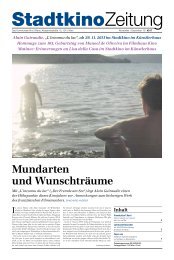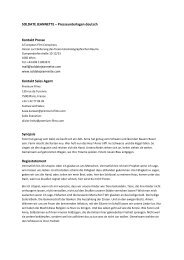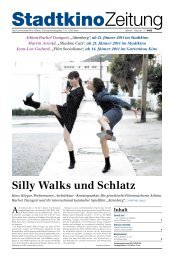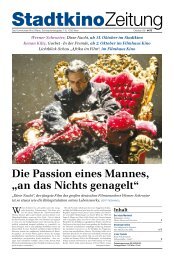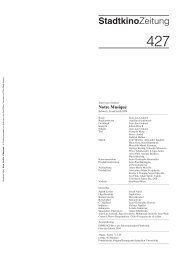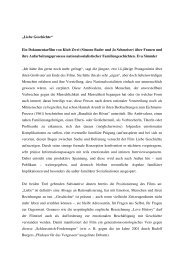Presseheft deutsch englisch - Stadtkino Wien
Presseheft deutsch englisch - Stadtkino Wien
Presseheft deutsch englisch - Stadtkino Wien
You also want an ePaper? Increase the reach of your titles
YUMPU automatically turns print PDFs into web optimized ePapers that Google loves.
——– K G P p r e s e n t s ——–Shirleyvisions of reality1A film by Gustav Deutsch" History is made up of personal stories"
Shirley – Visions of RealitySaturday, August 28 th 1931, Paris, 11 p.m.SynopsisIn 13 durch den Film zum Leben erweckten Gemälden von Edward Hopper wird dieGeschichte einer Frau erzählt (Story), die uns durch ihre Gedanken, Gefühle undReflexionen eine Epoche der Amerikanischen Geschichte betrachten lässt (History).Shirley ist eine Frau im Amerika der 30er, 40er, 50er und frühen 60er Jahre.Eine Frau, die in ihrem beruflichen und gesellschaftspolitischen Engagement denLauf der Geschichte mitbestimmen möchte. Eine Frau, die die Wirklichkeit derDepressionsjahre, des Weltkriegs, der McCarthy-Ära, der Rassenkonflikte undBürgerrechtsbewegungen nie als Gegebenheit ansieht, sondern als gemacht undveränderbar. Eine Frau, die als Schauspielerin mit der Inszenierung von Realität,mit der Darstellung von Wirklichkeit vertraut ist, die nicht in der Einzelkarriere undals Star ihre Zukunft und Bestimmung sieht, sondern als Mitglied eines Kollektivesgesellschaftliche Wirksamkeit des Theaters anstrebt. Eine Frau, die sich mit demherrschenden Rollenbild einer Ehegattin nicht identifiziert und dennoch einenLebenspartner haben möchte. Eine Frau, die sich im Moment der beruflichenKrise nicht arrangiert, keine Kompromisse eingeht und sich trotzdem nicht scheutJobs anzunehmen, die ihr das Überleben sichern. Eine Frau, die sich im Momentder privaten Krise für den Partner entscheidet und ihre beruflichen Interessenzurückstellt. Eine Frau, die auf politische Repression mit Wut aber nicht mitVerzweiflung reagiert und die für Verrat nur Verachtung übrig hat.Shirley – eine attraktive, charismatische, engagierte, emanzipierte Frau.Synopsis13 of Edward Hopper’s paintings are brought alive by the film, telling the storyof a woman, whose thoughts, emotions and contemplations lets us observe anera in American history.Shirley is a woman in America in the 1930s, ‘40s, ‘50s, and early ‘60s.A woman who would like to influence the course of history with her professionaland socio-political involvement. A woman who does not accept the realityof the Depression years, WWII, the McCarthy era, race conflicts and civilrights campaigns as given but rather as generated and adjustable. A womanwhose work as an actress has familiarised her with the staging of reality, thequestioning and shaping of it; an actress who doesn’t identify her purposeand future with that of solo success or stardom but who strives to give socialpotency to theatre as part of a collective. A woman who cannot identify with thetraditional role model of a wife yet longs to have a life partner. A woman whodoes not compromise in moments of professional crisis and is not afraid to takeon menial jobs to secure her livelihood. A woman who in a moment of privatecrisis decides to stick with her partner and puts her own professional intereston the back burner. A woman who is infuriated by political repression yet notdriven to despair, and who has nothing but disdain for betrayal.Shirley, an attractive, charismatic, committed, emancipated woman.1
Shirley – Visions of RealitySunday, August 28 th 1932, New York, 8 p.m.Statement des RegisseursAls Ausgangspunkt für diesen Film, der die Inszenierung von Realität und den Dialogvon Malerei und Film zur Basis hat, wählte ich Edward Hoppers malerisches Werk, daseinerseits vom Film Noir beeinflusst war – in der Darstellung des Lichts, in der Wahlder Sujets und der Bildausschnitte, wie in den Bildern Night Windows (1938), Officeat Night (1940), Room in New York (1932), oder das Kino selbst thematisierte, wiein New York Movie (1939) und Intermission (1963) – und andererseits Filmschaffendewie Alfred Hitchcock, Jim Jarmush, Martin Scorsese und Wim Wenders beeinflusste.Ausgehend von der Überzeugung, dass Geschichte durch persönliche Geschichtenvon Menschen gemacht wird, und beeinflusst von John Dos Passos USA Romantrilogie1 , in der die Lebensgeschichten und Schicksale Einzelner als Stellvertreterfür Viele amerikanische Lebens-, Sozial- und Kulturgeschichte repräsentieren, habeich für diesen Film als Hauptfigur eine Schauspielerin, Shirley, gewählt, durch diewir Amerika von Anfang der 30er, bis Mitte der 60er Jahre erleben und in innerenMonologen erzählt und reflektiert bekommen.Es sind drei Dekaden, in denen auf allen Ebenen – politisch, sozial, kulturell,gesellschaftlich – große Umwälzungen in Amerika stattfanden und das Land undseine Menschen für immer veränderten: Pearl Habor und der zweite Weltkrieg, dieAtombombe und die Eroberung des Weltalls, McCarthy und der Kalte Krieg, derMord an John F. Kennedy und der beginnende Vietnamkrieg, Duke Ellington und derBigband-Swing, Billie Holiday und der Südstaaten-Blues, Elvis Presley und der Rock’nDirector’s statementAs the starting point for this film, which has at its heart the staging of realityand the dialogue of painting and film, I selected Edward Hopper’s picturesqueoeuvre, which on the one hand was influenced by film noir – in his choice oflighting, subject and framing as seen in paintings such as Night Windows (1938),Office at Night (1940), Room in New York (1932) and his direct references tocinema such as in New York Movie (1939) and Intermission (1963) – and on theother hand influenced filmmakers such as Alfred Hitchcock, Jim Jarmusch,Martin Scorsese and Wim Wenders.Based on my conviction that history is made up of personal stories andinfluenced by my reading of John Dos Passos’ USA novel trilogy 1 in which the lifestories and destinies of a few are representative of the wider public and socialand cultural history of America, I have chosen an actress as the film’s protagonist– Shirley – through whose reflective and contemplative inner monologues weexperience America from the beginning of the 1930’s through to the mid-1960’s.Here we have three decades, which have seen great upheavals at all levels –political, social and cultural – that have changed the country and its peopleforever: Pearl Habour and WWII, the atomic bomb and the “conquest of space”,McCarthy and the Cold War, the assassination of John F. Kennedy and the startof the Vietnam War, Duke Ellington and the big band swing, Billie Holiday andthe Southern blues, Elvis Presley and the rock n’ roll, Bob Dylan, Joan Baez and21 The 42nd Parallel (1930), Nineteen Nineteen (1932), und The Big Money (1936)1 The 42nd Parallel (1930), Nineteen Nineteen (1932), and The Big Money (1936)
Shirley – Visions of RealityMonday, August 28 th 1939, New York, 10 p.m.Roll, Bob Dylan, Joan Baez und der Protestsong, The Group Theatre, The LivingTheatre, The Actors Studio und die daraus hervorgehenden Filmstars Anne Bancroft,Marlon Brando, James Dean, Marilyn Monroe. Der Börsencrash und die Depression,Rassenunruhen und der Ku-Klux-Klan, der Marsch auf Washington und Martin LutherKing. Ereignisse, Namen, Legenden, die sich ins kollektive Gedächtnis eingeschriebenhaben, die Bilder evozieren, Stimmungen hervorrufen. Shirley erlebt und reflektiertall dies aus der Perspektive einer engagierten, emanzipierten und politisch dem linkenSpektrum zugeordneten Schauspielerin. Sie mag Jazz, hört gerne Radio, geht gerneaus, liebt den Film. Sie steht mit beiden Beinen im Leben – auch in beruflichen undprivaten Krisenzeiten – und ist eine Frau mit inneren Überzeugungen. Sie ist attraktiv,charismatisch und spielt gerne Außenseiterrollen. Außer der Kunst gilt ihr Interesseauch gesellschaftspolitischen Fragen. Kunst und gesellschaftspolitisches Engagementvereint sie als Ensemblemitglied des Group Theatres und des Living Theatres.Mit ihrem Partner Stephen, einem Fotojournalisten der New York Post, teilt sie zwarnur zweimal in diesen drei Dekaden eine Wohnung, dennoch sind ihre privaten undberuflichen Schicksale tief miteinander verbunden: Arbeitslosigkeit als Folge derDepression, Enttäuschung durch Verrat von Mitgliedern des Group Theatre vor demMcCarthy Ausschuss, Repressionen auf Grund von politisch engagiertem Theater,Ausstieg aus der beruflichen Karriere wegen Krankheit des Partners, Verlust desPartners, Rückzug aufs Land und Infragestellung der gesellschaftlichen Wirksamkeitvon Kunst, Emigration nach Europa – private Schicksale vor dem Hintergrundvon und beeinflusst durch weltverändernde Ereignisse, kulturelle Revolutionen,gesellschaftspolitische Umwälzungen.the protest song, The Group Theatre, The Living Theatre, The Actor’s Studioand its affiliated movie stars such as Anne Bancroft, Marlon Brando, James Dean,Marilyn Monroe, the Stock Market Crash, the Depression, race riots and theKu-Klux-Klan, the March on Washington and Martin Luther King. These events,names and legends, which are inscribed into our collective memory, evokeimages and moods. Shirley experiences and reflects all this as a committed andemancipated actress with left-leaning politics. She enjoys jazz, listening to theradio and going out and loves film. She is a woman with strong opinions andboth feet on the ground, even during times of personal or professional crisis.She is attractive, charismatic and likes to play outsider roles. Besides art, she isalso interested in socio-political issues. As an ensemble member of the GroupTheatre and Living Theatre she combines art with her socio-political involvement.While Shirley and her partner Stephen, a photojournalist for the New York Post,share an apartment on only two occasions during these three decades, theirprivate and professional lives are deeply connected: unemployment as a resultof the Depression, disappointment after the betrayal of Group Theatre membersin front of the McCarthy committee, repressions as a result of the politicallymindedtheatre, career retirement as a result of an ill partner, loss of the partner,retirement to the countryside and questioning of the effectiveness of art, emigrationto Europe – personal destinies that are pursued in front of and influencedby world-changing events, cultural revolutions and socio-political upheavals.History is made up of personal stories. Gustav Deutsch, January 20133Persönliche Geschichten machen Geschichte. Gustav Deutsch, Jänner 2013
Shirley – Visions of RealityWednesday, August 28 th 1940, New York, 10 p.m.Gustav Deutsch im Gespräch mit Karin Schieferüber Shirley – Visions of Reality (Auszüge)Gustav Deutsch talking to Karin Schiefer aboutShirley – Visions of Reality (excerpts)Bisher sind viele Ihrer Arbeiten auf der Basis von aufgestöbertem odergezielt gesuchtem Bildmaterial entstanden. Diesmal ist Ihr „gefundenes Objekt“Edward Hopper. Was hat Sie an ihm so fasziniert?An Hopper faszinierten mich zweierlei Dinge, die mir nicht sofort bewusst waren:zum einen ließ er sich als begeisterter Kinogänger sehr stark vom Film beeinflussen.In seinen Lichtsetzungen und seiner Ausschnittswahl gibt es klare Referenzen zumfilm noir, und er hatte durch seine Bilder wiederum Einfluss auf Filmschaffende.Alfred Hitchcock hat sich für Psycho ganz klar an Hoppers House by the Railroadorientiert. Bis heute beziehen sich Filmschaffende wie Wim Wenders oder JimJarmusch auf ihn. Der zweite faszinierende Punkt war der, dass Hopper alsrealistischer Maler gilt, was sich bei meiner tieferen Auseinandersetzung mit seinenGemälden gar nicht bewahrheitet hat. Hopper bildet Wirklichkeit nicht ab, sonderner inszeniert sie. Wirklichkeit zu inszenieren und zusammenzusetzen ist etwas, dasauch dem Film inhärent ist.Sie haben nicht nur einen Schritt getan vom Found Footage-Material zur Malerei,Sie haben sich auch vom essayistisch-experimentellen Arbeiten zum fiktivenErzählen bewegt. Was hat Sie zur Fiktion geführt?Die Bilder waren da. Allerdings nur die Bilder und nicht der Kontext. In meinenvorangehenden Arbeiten brachte ich Bilder aus verschiedensten Filmen inUp to now, you have created many of your artworks by happening uponor tracking down found footage material. This time your “found object” isEdward Hopper. What fascination does he hold for you?There are two things about Hopper that fascinated me, which weren’t clear tome at the beginning: firstly, as an avid cinemagoer he was strongly influencedby film. He clearly references film noir by the way he uses lighting and frames hissubjects, and he also had a strong influence on filmmakers through his paintings.When Alfred Hitchcock shot Psycho, he was clearly guided by Hopper’s Houseby the Railroad. Even today, filmmakers like Jim Jarmusch and Wim Wendersrefer to him. Secondly, Hopper is considered a realist painter, which is notsomething I found to be true upon closer analysis of his paintings. Hopper doesnot portray reality but stages it. The staging and assembling of reality is also thenature of film.You have not only stepped away from found footage material to painting,you have also moved from essayist, experimental works to fictional narration.What brought you to fiction?There were the paintings. Albeit, just the paintings and not the context.In my previous work, I established a connection between the images of diversefilms. Through montage, I managed to create meaning contexts by attempting4
Shirley – Visions of RealityFriday, August 28 th 1942, New Haven, 8 p.m.Zusammenhang. Ich erzeugte durch die Montage Bedeutungszusammenhänge undversuchte etwas aufzuspüren, was ursprünglich von den FilmemacherInnen nichtintendiert war. Es ging mir um das Erzählen von neuen Geschichten, dieser Ansatzist Shirley – Visions of Reality nicht so fern. Ich erzähle ja auch mit Hoppers Bildern„andere“ Geschichten. Mir ging es darum, anhand einer Figur, das ist bei EdwardHopper meist eine Frau, dreißig Jahre amerikanischer Geschichte zu erzählen, undzwar jene Zeit, die sich mit der Entstehung der Bilder deckt: im Spiegel dieser Frauund durch die Augen dieser Frau. So kann ich auch Dinge einbringen, die in denBildern nicht abgebildet sind. Faszinierend bei Hopper ist, dass seine Protagonistenetwas erleben oder beobachten, das sie mit uns nicht teilen, weil es nicht dargestelltist. Viele der dargestellten Frauen schauen aus dem Fenster, sehen etwas, reagierenauf etwas, von dem wir nicht wissen, was es ist, und das kann ich natürlich erfinden.Ich kann es über den Ton oder den inneren Monolog dieser Frau einbringen.Wie hat das Drehbuch, das gewiss kein „klassisches“ Drehbuch war, ausgesehen?Was mich in meinem Schaffen immer wieder beschäftigt, ist die Reflexion überdie Geschichte des Kinos und des Films. Das Tableau vivant ist ein Vorläuferder Kinematographie. Es war ein beliebtes gesellschaftliches Vergnügen im19.Jahrhundert, berühmte Gemälde nachzustellen und der Film hat in seinenAnfängen dieses Unterhaltungselement übernommen. Bei mir stand die Idee,Bilder zum Leben zu erwecken, im Zentrum. Ich wollte mir ausdenken, waskurz vor und kurz nach diesem Moment, wo das Bild in Hoppers Gemäldeeingefroren ist, passiert. Am Beginn drehten sich meine Gedanken darum, welcheBewegungsabfolgen die Frau vollziehen könnte – setzt sie sich hin oder kommt sieherein? Sehr früh hatte ich daher die Idee, nicht mit einer Schauspielerin, sondernto unearth something that was not the original intention of the filmmakers.I wanted to narrate new stories, and this is also true for Shirley – Visions ofReality. I tell “other” stories with Hopper’s pictures as well. By means of acharacter, which for Edward Hopper is usually a woman, I intended to narratethirty years of American history, the same time period that coincides with thecreation of the pictures: through the reflection of this woman and through hereyes. That way, I can introduce elements that are not shown in the pictures.What is fascinating about Hopper is that his protagonists experience or observesomething that they do not share with us, because it is not depicted. Manyof the pictured women look out of the window, observe something, react tosomething and we do not know what it is, and this is of course something I caninvent. I can introduce it through sound or the woman’s inner monologue.What did the screenplay look like - surely nothing like a „classic“ screenplay?In my oeuvre, I am again and again concerned with the reflection of the historyof cinema and film. The tableau vivant is a precursor of cinematography. It wasa popular social past time to re-enact famous paintings, and film in its earlystages also assumed this form of entertainment. My main idea was to “vivify”the pictures. I wanted to imagine what happened shortly before and after themoment that remains frozen in Hopper’s painting. At the beginning my thoughtsturned to the sequence of moves the woman would do – does she sit down orenter the room? Very early on, my idea was to work with a dancer, rather thanan actress, because this work is much more about gestures and movements.Only later did I start contemplating her character. What is her profession?What are her interests? I started to think out thirty years of this woman’s life.5
Shirley – Visions of RealityThursday, August 28 th 1952, New York, 6 a.m.mit einer Tänzerin zu arbeiten, weil es ja vielmehr eine Arbeit über Gestik, überBewegung ist. Erst in einer späteren Phase begann ich, mir die Figur zu überlegen.Welchen Beruf hat diese Frau? Was interessiert sie? Ich begann, mir die dreißigJahre des Lebens dieser Frau auszudenken. Ihr Vorleben hat mich überhaupt nichtbeschäftigt, sondern nur diese 30 Jahre ihres beruflichen und persönlichen Lebens.Im Beruf meiner beiden Protagonisten – es gibt auch eine männliche Hauptfigur,ihren Lebenspartner Stephen – sollte sich das Thema, um das es mir geht,widerspiegeln: Auseinandersetzung mit und Abbildung, Inszenierung von Realität.Darum ist meine Protagonistin Schauspielerin, ihr Lebenspartner Fotojournalist.Diese Frau ist aber nicht nur eine Schauspielerin, die darauf schaut, Rollen zu kriegen,sie lebt diese dreißig Jahre mit einer politischen Überzeugung und Engagement?Ich wollte eine starke Frauenfigur, die kompromisslos agiert und einen Weg geht,der vom Gedanken getragen ist, dass man das Leben nicht als Schicksal annimmt,sondern als etwas, das man gestalten kann, auch in dieser Zeit und auch alsFrau. In ihrem Beruf schien mir dafür wichtig, dass sie das nicht alleine realisiert,sondern in einer Gruppe. Im Theaterbereich gab es damals das von KonstantinStanislawski inspirierte Group Theatre, der das „method acting“ entwickelt hat.Diese Methoden bedingten, dass sich die Schauspieler nicht nur auf der Bühneund bei den Proben treffen, sondern auch Wohngemeinschaften bilden, um sichauch persönlich nahe zu sein. Diesen Weg geht auch meine Protagonistin, die übereine gewisse Zeit nicht bei ihrem Partner lebt, sondern sich der Gruppe anschließt.Ihr Lebenspartner unterstützt sie dabei sehr, er hat als Fotojournalist auch denviel kompromissfähigeren Beruf, er hat ein ständiges Einkommen und kann sie inZeiten, wo sie arbeitslos ist und das Group Theatre zerbricht, aufnehmen. Es gibtI was merely interested in these thirty years of her professional and private life,not her earlier experiences. The professions of my protagonists – there is alsoa principal male character – should reflect the theme: the discussion, reflectionand staging of reality. This is why my protagonist is an actress and her lifepartner a photojournalist.But this woman is not only an actress concerned with getting parts, in thesethirty years she is also politically minded and involved?I wanted a strong female character, who acts uncompromisingly, and whotakes an approach supported by the idea that one is not born into a givendestiny but that life can be created as it unfolds, even in these times, and asa woman. Regarding her profession, it was important to me that she wouldachieve this not on her own but within a group. In theatre, back then, there wasthe Group Theatre, inspired by Konstantin Stanislavski, who also developed“method acting”. These methods require the actors to live together in closelyknitcommunities, rather than only meet up on stage and during rehearsals.My protagonist also takes this approach and for a time does not live withher partner but with the group. Her partner supports her fully, his job as aphotojournalist enables him to be more compromising, he has a steady incomeand, during the time when she is unemployed and the Group Theatre dissolves,he is able to take her in. Among the 13 Hopper paintings, there are a few thatdidn’t allow me to define Shirley as an actress – she then works as a secretaryat her partner’s newspaper or as an usherette at the cinema. Her periods ofunemployment coincide with the Depression of the 1930s, the crisis of whichsaw her out of work as an actress, but her political convictions also stopped her6
Shirley – Visions of RealityWednesday, August 28 th 1957, Pacific Palisades, 6 p.m.für alles, was malerisch dargestellt werden muss, zu sein, sondern auch das farblicheGesamtkonzept zu entwerfen und mit mir gemeinsam der Frage nachzugehen,worin die faszinierende Wirkung der Farben bei Edward Hopper liegt. Im Laufe einerAmerikareise haben wir uns die Bilder in den Museen angeschaut und haben vonden Originalgemälden mit Farbfächerkarten die Farben abgenommen. Mit HannasFarbvorgaben arbeiteten wir dann am Set. Sie bestimmte die Farben, die sich aberdurch das darauf fallende Licht wieder völlig verändert hatten und dann schautenwir uns die digital gedrehten Bilder am Monitor an und es war wieder ganz anders.Wir befanden uns in einer permanenten Auseinandersetzung mit Farben und Farbkartenund das ist bis zur Lichtbestimmung und Farbkorrektur so weiter gegangenen.Ich wollte das, was Hoppers Malerei ausmacht, nämlich dieses faszinierende Spielmit Kalt und Warm, mit Licht und Schatten, auf die Leinwand tragen.Die Transformation des Raums von der Malerei in den Film stellte Sie gewiss auchals Architekt vor einige Herausforderungen?Der Raum ist ein Spiel mit dem Machbaren. Hopper hat im Fall von Office atNight zum Beispiel eine Blickperspektive, die der einer Überwachungskameragleichkommt. Um das, was er malt, darzustellen, mussten wir alle Möbel so starkkippen, dass durch die Schrägstellung beinahe nichts mehr auf den Tischen hielt.Die Beschäftigung mit Hoppers Räumen hat mich natürlich als Architekt sehrinteressiert: Wie kann man solche Räume dreidimensional nachbauen? Ich musstemehrere Modelle bauen, um mich überhaupt anzunähern.Ist vieles von Hoppers subversiven Raumanordnungen erst beim Bauen zuTage getreten?the colours, which changed with the light, and when we watched the digitallyshot images on screen, they had changed again. We were constantly discussingcolours and colour charts and this went on throughout the colour correction andcolour grading processes. I wanted to transfer that which defines Hopper’s work,this fascinating play of cold and warm, light and shadow, onto the big screen.Surely the transformation of space from painting to film was also a challengefor you as an architect?Space is a play with the possible. In Office at Night, for example, Hopper usesan angle, which approximates that of a CCTV camera. In order to recreate whathe painted, we had to tilt all the furniture to such an extent that the tilt lefteverything flying off the table. Of course, Hopper’s preoccupation with spaceswas of great interest to me as an architect: How is it possible to recreate theserooms three dimensionally? I had to build several models in order to even comeclose.Did many of Hopper’s subversive spatial arrangements only become apparentduring the building phase?Yes. The dimensions he worked with are unbelievable. Often his beds are threemetres in length. Then there are armchairs so narrow that it is almost impossibleto sit in them. It was important to consider which elements were to be played on,what targets were viable. Things that are not used can be built so they look likethey function but don’t. And everything is anamorphic, no furniture is placed ata right angle, no space is orthogonal.8
Shirley – Visions of RealityFriday, August 28 th 1959, Cape Cod, 11 a.m.Ja. Es ist unglaublich, mit welchen Dimensionen er arbeitete. Oft sind Betten dreiMeter lang, dann gibt es wieder so enge und schmale Fauteuils, dass man kaumdarin sitzen kann. Man musste überlegen, welche Elemente bespielt werden, wasvon den Vorgaben praktikabel ist und was nicht. Was nicht benutzt wird, kann manauch so bauen, dass es so aussieht als ob, ohne dass es funktionieren muss.Und alles ist anamorphotisch, kein Möbel im rechten Winkel, kein Raum orthogonal.Vor welche Aufgaben stellte Sie das Licht?Das Licht ist neben den Figuren ein weiterer Hauptdarsteller, es erforderte ebensoviel Aufmerksamkeit wie die Inszenierung der Schauspieler oder die Farbgestaltungdes Sets. Die Lichtsetzung dauerte ungefähr genauso lange, wie dann die Drehzeitausmachte, cirka einen bis eineinhalb Tage. Jerzy Palacz der Kameramann und DominikDanner der Oberbeleuchter arbeiteten an der Umsetzung der Licht und SchattenweltHoppers seit dem Pilotfilm. Auch sie waren davon besessen, die Darstellung desgemaltes Lichtes so getreu und nahe an dem Hopper-Bild wie möglich umzusetzen.Bei manchen Bildern stießen wir an die Grenzen der Machbarkeit und wir warenpermanent vor Fragen gestellt – was wollen wir zulassen? Was nicht? Wirft unsereHauptfigur, wenn sie vor dem Fenster steht, einen Schatten oder nicht? Wie machenwir es glaubhaft, selbst wenn es nicht dem Hopper-Bild entspricht. Unsere Arbeitmusste ja auch im filmischen Sinn glaubhaft sein, so wie ein Hopper-Bild als Gemälde.Blieben die Kameraeinstellungen in der Totalen?Nein. Mindestens ein Frame stimmt im Laufe jeder Episode in der Totalen exaktmit dem Hopper-Bild überein. Wir durften die Kameraposition nicht verlassen, auchWhat was the challenge regarding the lighting?Lighting plays a major part, not unlike the characters, requiring as muchattention as the mise-en-scène of actors or the colour design of the set.The lighting design took up as much time as the shoot, about one to one anda half days. Jerzy Palacz, the cinematographer, and Dominik Danner, the gaffer,worked on the realization of Hopper’s world of light and shadows, ever sincewe shot the teaser. They were also obsessive in their endeavour to recreate thepainted light in Hopper’s picture as accurately as possible. With some pictureswe were stretching the limits of possibility and we were frequently faced withquestions such as: What should or shouldn’t we allow? Will our protagonistthrow a shadow if she stands in front of the window or not? How can we makeit look real, even if it is not in the Hopper painting? Evidently, our work has tobe credible in a cinematic sense as well, like a Hopper painting has to work asa painting.Are there only long shots in the film?No. At least one moment in each episode is an exact match of the Hopperpainting. We were not allowed to move the camera position, not even by threecentimetres, because otherwise things would have looked out of place. But wewere able to zoom in and out, change the shot size, and as far as possible,even pan. Despite his limited scope for manoeuvre, Jerzy Palacz got the mostout of what was available ...... and thus pushing cinema to its limits?9
Shirley – Visions of RealityMonday, August 28 th 1961, Cape Cod, 7 a.m.nicht um drei Zentimeter, weil sonst nichts mehr übereinstimmte. Aber wir konnteneinzoomen, auszoomen, Ausschnitte nehmen und im Rahmen des Möglichen auchschwenken. Jerzy Palacz hat trotz geringem Handlungsspielraum aus den Vorgabendas Meiste herausgeholt ...... und reizte damit die Möglichkeiten des Kinos bis an seine Grenzen aus?Wir waren limitiert. Wir konnten weder mit der Handkamera herumgehen, nochSchuss und Gegenschuss machen. Wir waren stets in der Beobachter-Position.Es ist Hopper sehr inhärent, eine eher voyeuristische und beobachtende Positioneinzunehmen. Es ging in allen Departments in diesem Projekt nicht darum, sichgroße Freiheiten zu nehmen, sondern darum, sich ins Detail zu vertiefen und mitdem Vorhandenen zu arbeiten. Die Herausforderung liegt natürlich darin, dassdas nicht langweilig wird, sondern dass man minimalistisch Spannung erzeugt.Wie das beim Publikum ankommt, wird man jetzt beurteilen können, wenn man90 Minuten auf der Leinwand gesehen hat.We were limited. We could neither walk around with a hand-held camera,nor do a shot reverse shot. We were always in the position of the spectator.It is very much like Hopper to assume a voyeuristic and observant position.In all departments of this project, it wasn’t about taking liberties but puttingtime into detail and working with what is available. The challenge is of courseto avoid boredom and create suspense in a subtle way. How this works,we can judge now, after watching 90 minutes on the big screen.(The complete interview can be found on the website of the Austrian Film Commission www.afc.at)10(Das vollständige Interview ist auf der Hompage der Austrian Film Commission nachzulesen www.afc.at)
Shirley – Visions of RealityWednesday, August 28 th 1963, Albany, 7 p.m.Biography Gustav DeutschFilmmaker, artist, lives and works in Vienna and Aegina. Born 1952 in Vienna, primaryschool, grammar school, architectural studies at the Technische Universität <strong>Wien</strong>.1979, graduation with Dipl.-Ing.. 1980–1983, member of the Medienwerkstatt <strong>Wien</strong>,numerous video artworks.Since 1983, member of the artists group DER BLAUE KOMPRESSOR,Flosting & Stomping Company. Since 1984, joint works with Hanna Schimek (D&S).Since 1989, numerous film works. Since 1996, member of SIXPACKFILM.Since 2003, artistic director of the AEGINA ACADEMY / A Forum for Art & Science.Works about the phenomenology of film, including:TASCHENKINO, 1995; FILM IST. 1– 6, 1998; FILM IST. 7–12, 2002; WELT SPIEGEL KINOEpisode 1–3, 2005; FILM IST. a girl & a gun, 2009Participation in international festivals, awards and prizes, including:Preis Neues Kino/Viennale 96, for TASCHENKINO and FILM IST MEHR ALS FILM, 1996;Main Price, Filmfestival Ann Arbor, for FILM IST. 1– 6, 2000; Curators Award, Cinema Texas, forFILM IST. 7–12, 2002; Best Film, EXiS Mediafestival, Seoul, for WELT SPIEGEL KINO, 2005Conception, organisation and realization of interdisciplinary art projects, including:JARDIN DE WILTZ, 1983 –1987 (2) ; DIE KUNST DER REISE, <strong>Wien</strong> 1986/87, Frankfurt 1988,London 1991 (1) ; ODYSSEY TODAY / THE ATHENS CONFERENCE, Athens, 1995 (1) ;LICHT BILD – DIE AEGINA AKADEMIE (1) , Aegina, 2003 / 2005; CAFE MELANGE, <strong>Wien</strong>,2008 (1) . Förderungspreis für Bildende Kunst, BMUK, for DIE KUNST DER REISE, 1992 (1)Together with: (1) Hanna Schimek; (2) Der Blaue KompressorFilmography (excepts):2010 PRIVATE SANDNES – a kinematographic atlas, Video, colour / b&w, 30 min2010 VISIONS OF REALITY – Pilot film, 35 mm, colour, 12 min2009 FILM IST. a girl & a gun, 35 mm, colour, 93 min2006 Die Mozarts, 35 mm, colour, 1 min (3)2005 Tatort Migration 1–10, 10 channel DVD Installation (5)2005 Welt Spiegel Kino, 35 mm, b&w, 90 min (5)2002 Film ist. 7–12, 35 mm, colour / b&w, 90 min (5)1999 K&K&K, Video, colour, 12 min1998 Film ist. 1–6, 16 mm, colour / bw, 60 min (5)1996 no comment – minimundus austria, 35 mm, b&w, 13 min (5)1996 Mariage blanc, 16 mm, colour, 5 min (4)1996 Film ist mehr als Film, Trailer Viennale 96, 35 mm, colour / b&w, 1 min1996 Taschenkino der Katalog, 16 mm, b&w, 30 min1995 Taschenkino, S 8, 100 Loops, colour, Expanded Cinema1995 Film / spricht/ viele / Sprachen, Trailer Viennale 95, 35 mm, colour, 1 min (5)1993 Augenzeugen der Fremde, 16 mm, colour, 33 min (1)1992 Internationaler SendeschluSS, Videoinstallation1990 Welt / Zeit 25812 min, 16 mm, b&w, 35 min (1)1990 Sa. 29 Juni / Arctic Circle, 16 mm, colour, 3 min1990 Adria-Urlaubsfilme 1954 – 68, 16 mm, colour / b&w, 35 min (5)1988 No je ne regret rien / Der Himmel über Paris, S 8 / 16mm, colour, 2 min1984 Wossea Mtotom, Video, colour / b&w, 70 min (2)1982 Asuma, Video, colour, 20 min (2)1981 Fulkur, Video, b&w, 20 min (1)1981 Rituale, Video, b&w, 35 min (1)Together with: (1) Ernst Kopper; (2) Gerda Lampalzer and Manfred Neuwirth;(3) Hanna Schimek; (4) Mostafa Tabbou; (5) Found Footage11
Shirley – Visions of RealityThursday, August 29 th 1963, Albany, 9 a.m.Biography Stephanie CummingStephanie Cumming is a Canadian dancer, choreographer and performer living inVienna. She was born in northern British Columbia in 1977 and graduated fromthe University of Calgary with a Bachelor of Arts in Contemporary Dance in 2000.In 2001 she relocated to Vienna where she has been living and working ever since.She has been working primarily with Austrian choreographer Chris Haring for thepast ten years and together with him and musician Andreas Berger and dramaturgeThomas Jelinek created the internationally acclaimed dance company Liquid Loft in2005. Cumming has performed in all of Liquid Loft’s repertoire throughout Europeas well as Asia, including Posing Project B: The Art of Seduction which wonthe Golden Lion for best performance at the Venice Biennale in 2007. She recentlyappeared on stage with Vienna based theatre company Toxic Dreams. Her ownwork has been presented in Austria at Tanzquartier <strong>Wien</strong> and the Impulstanz festival,as well as internationally in Holland, Slovenia and Hungary. Through her work withLiquid Loft she has appeared in many films from Austrian-Bulgarian filmmakerMara Mattuschka, including Burning Palace. Other film collaborations includethe short film Tell by Erwin Wurm and a yet to be released short film by Austrianfilmmaker Harald Hund. She plays the main role of Shirley in Gustav Deutsch’s latestfilm Shirley – Visions of Reality.Biography Christoph BachBorn in 1975, Christoph Bach completed his actor training at the University ofFine Arts in Berlin. In 2003 he gave his debut in the black comedy NARREN.Further films: 2005, the award-winning diploma film KATZE IM SACK; 2004,CLOSE; 2005, ZEPPELIN; 2008, SCHATTENWELT; 2008, FINNISCHER TANGOand 2011, DAS SCHLAFENDE MÄDCHEN. In 2003 Christoph Bach was awardedthe German Cinema New Talent Award for Best New Actor for his role inDETROIT (directed by Carsten Ludwig and Jan-Christoph Glaser). The TV dramaMEIN MÖRDER (directed by Elisabeth Scharang), in which he plays the maincharacter, was awarded the Austrian TV Award and the main prize of the FIPAtelevision festival in Biarritz. Several other TV productions followed. In 2006 theZDF’s Das kleine Fernsehspiel dedicated a four-part series of feature films to hiswork. In 2010 he appeared in the Golden Globe-winning three-part miniseriesDER SCHAKAL by Olivier Assayas and 2008 in the docudrama DUTSCHKE,which was awarded the German Television Award.12
Shirley – Visions of RealitySunday, August 29 th 1965, Cape Cod, 10 a.m.KGP Kranzelbinder Gabriele ProductionWe are an independent film production company located in Vienna, going since2001. We first made films under the name of Amour Fou, until 2007, whenGabriele Kranzelbinder established the KGP under her sole ownership, known forinternationally successful and both in content and format transgressive productionswith international filmmakers of all genres. Our films have been exhibited at all majorfestivals (Cannes, Berlin, Venedig, Locarno, Toronto etc.) and have won numerousawards. Our name is synonymous with the classic European auteur film as well asexperimental cinema and the avant-garde. We tell stories and invite the spectatorto come on a journey with us to experience exciting narratives, exotic locations,unknown realities and all aspects of the human world of emotions.Filmography (excerpts)MUSEUM HOURS, Jem Cohen, 2012, FeatureGRIFFEN – On the tracks of Peter Handke, Bernd Liepold-Mosser, 2012, DocumentaryWHAT IS LOVE, Ruth Mader, 2012, DocumentaryTHE FATHERLESS, Marie Kreuzer, 2011, FeatureCARLOS, Olivier Assayas, 2010, Feature (Executive production Austria)TENDER SON – THE FRANKENSTEIN PROJECT, Kornèl Mundruczó, 2010 , FeatureMUEZZIN, Sebastian Brameshuber, 2009, DocumentaryUNIVERSALOVE, Thomas Woschitz, 2008, FeatureTAXIDERMIA, György Pálfi, 2006, FeatureSTRUGGLE, Ruth Mader, 2003, FeatureTechnical information2013, 93 min, Color, DCP, 1:1,85, 24 f/sec, Digital Sound 5.1.CreditsWriter / Director / Production Designer / Editor: Gustav DeutschKey Scenic Artist / Head Painter: Hanna SchimekDirector of Photography: Jerzy PalaczAssistant Director / Script Continuity: Bernadette WeigelKey Grip / Gaffer: Dominik DannerCostume Designer: Julia Cepp – mija t. rosaKey Make-up Artist / Hairdresser / Costume Standby: Michaela HaagComposer Original Music: Christian Fennesz, David SylvianSound: Christoph AmannScript Consultant / Creative Producer: Tom SchlesingerProduction Manager / Line Producer: Marie TapperoProduced by Gabriele KranzelbinderProductionKGP Kranzelbinder Gabriele ProductionCASTShirley – Stephanie CummingStephen – Christoph BachMr Antrobus / Cinema Goer – Florentin GrollMrs Antrobus / Cinema Goer / First Train Passenger – Elfriede IrrallChief Clerk – Tom Hanslmaierand Yarina Gurtner Vargas, Peter Zech, Alfred Schibor, Jeff Burrell,Jim Libby, Dennis Kozeluh, Anne Weiner, Julien Avedikian13
CONTACTPRODUCTIONKGP KRANZELBINDER GABRIELE PRODUCTION GmbHSeidengasse 15 / 3 / 191070 Vienna, AustriaFon + 43 – 1 – 522 22 210welcome@kgp.co.atFESTIVALSAUSTRIAN FILM COMMISSIONStiftgasse 61070 Vienna, AustriaFon + 43 – 1 – 526 33 23Fax + 43 – 1 – 526 68 01festivals@afc.atPRESSInes KratzmüllerFon + 43 – 699 – 12 64 13 47ines@kratzmueller.comBERLINALE ScreeningsFri 8 th Feb. 2013 9:30 CinemaxX 6 (press screening)Sat 9 th Feb. 2013 22:00 CineStar EventSun 10 th Feb. 2013 12:30 ArsenalMon 11 th Feb. 2013 9:20 CinemaxX 13 (market screening)Tue 12 th Feb. 2013 13:45 CineStar 8Sun 17 th Feb. 2013 20:00 Cubix 9Supported by




